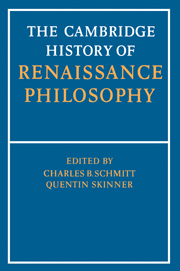Book contents
- Frontmatter
- Introduction
- PART 1 THE INTELLECTUAL CONTEXT
- PART 2 PHILOSOPHY AND ITS PARTS
- 6 Logic and language: Traditional logic
- 7 Logic and language: Humanistic logic
- 8 Natural philosophy: Traditional natural philosophy
- 9 Natural philosophy: The new Philosophy of nature
- 10 Natural philosophy: Astrology and magic
- 11 Moral philosophy
- 12 Political philosophy
- 13 Psychology: The concept of psychology
- 14 Psychology: The organic soul
- 15 Psychology: The intellective soul
- 16 Metaphysics
- 17 Problems of knowledge and action: Fate, fortune, providence and human freedom
- 18 Problems of knowledge and action: Theories of knowledge
- 19 Problems of knowledge and action: Epistemology of the sciences
- 20 Philosophy and humanistic disciplines: Rhetoric and poetics
- 21 Philosophy and humanistic disciplines: The theory of history
- PART 3 SUPPLEMENTARY MATERIAL
- Biobibliographies
- Bibliography
- Index nominun
- Index rerum
- References
9 - Natural philosophy: The new Philosophy of nature
from PART 2 - PHILOSOPHY AND ITS PARTS
Published online by Cambridge University Press: 28 March 2008
- Frontmatter
- Introduction
- PART 1 THE INTELLECTUAL CONTEXT
- PART 2 PHILOSOPHY AND ITS PARTS
- 6 Logic and language: Traditional logic
- 7 Logic and language: Humanistic logic
- 8 Natural philosophy: Traditional natural philosophy
- 9 Natural philosophy: The new Philosophy of nature
- 10 Natural philosophy: Astrology and magic
- 11 Moral philosophy
- 12 Political philosophy
- 13 Psychology: The concept of psychology
- 14 Psychology: The organic soul
- 15 Psychology: The intellective soul
- 16 Metaphysics
- 17 Problems of knowledge and action: Fate, fortune, providence and human freedom
- 18 Problems of knowledge and action: Theories of knowledge
- 19 Problems of knowledge and action: Epistemology of the sciences
- 20 Philosophy and humanistic disciplines: Rhetoric and poetics
- 21 Philosophy and humanistic disciplines: The theory of history
- PART 3 SUPPLEMENTARY MATERIAL
- Biobibliographies
- Bibliography
- Index nominun
- Index rerum
- References
Summary
INTRODUCTION
The intellectual ferment of the early sixteenth century profoundly influenced the education and training of a group of thinkers who by the middle of the century were beginning to elaborate a new vision of nature. Its principal features were first, a new cosmology, showing in some cases the influence of Copernicus and always critical of the dominant categories of Aristotelian physics (space, place and motion), and second, the view that nature might be usefully transformed in the interests of mankind. This latter view oscillated between speculations about operative magic linked with astrology and ideas of direct intervention in nature armed with an empirical understanding of the specific causes of particular phenomena.
Despite their differences – and the speculations of some, like Cardano, Bruno and Campanella, often took on a religious significance of prophetic inspiration – a common theme was the demise of the belief that the study of nature consisted solely in the study of Aristotle, who had reduced its whole structure to a handful of categories capable of explaining its universal processes. The natural philosopher could no longer rest content with glosses and commentaries that clarified textual rather than concretely physical problems. Indeed, it began to seem as if nature consisted of an almost infinite number of processes awaiting discovery, and any general account of causality required this unveiling of nature's ‘secrets’ to be linked to empirically acquired knowledge.
- Type
- Chapter
- Information
- The Cambridge History of Renaissance Philosophy , pp. 236 - 263Publisher: Cambridge University PressPrint publication year: 1988
References
- 11
- Cited by



